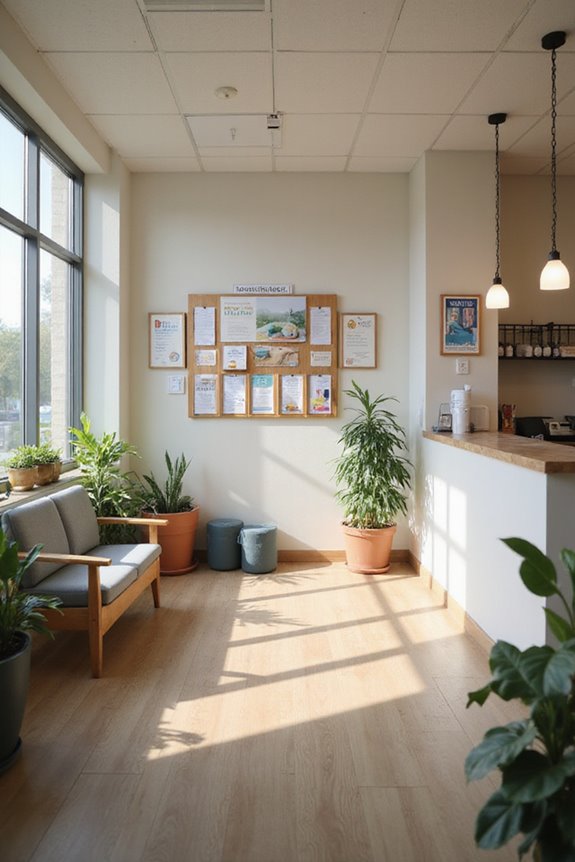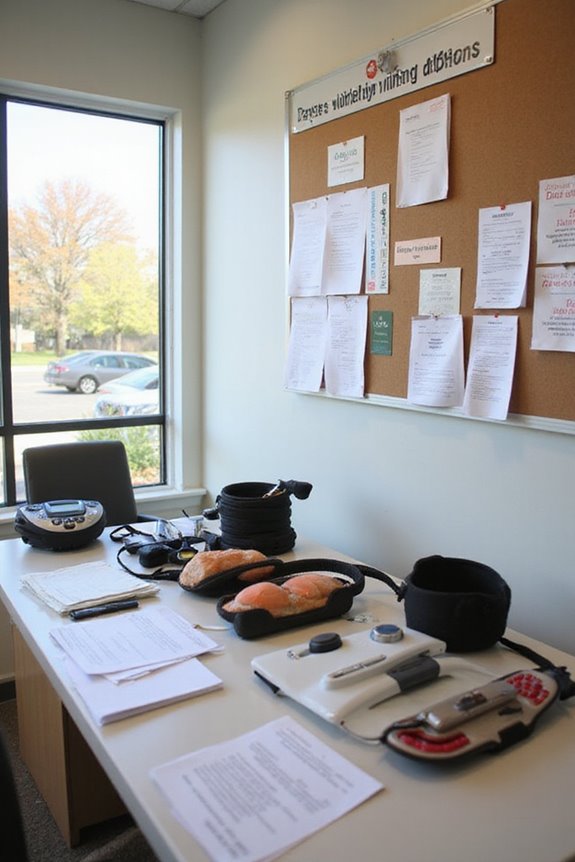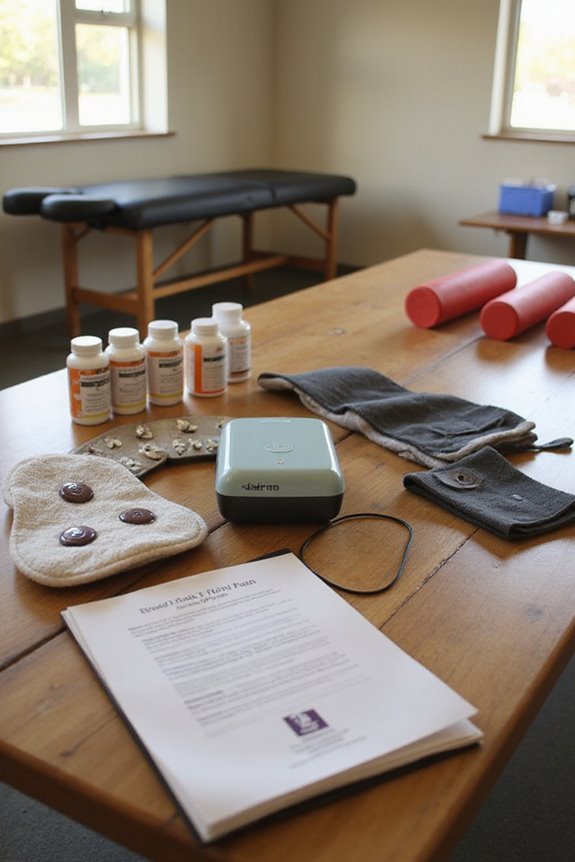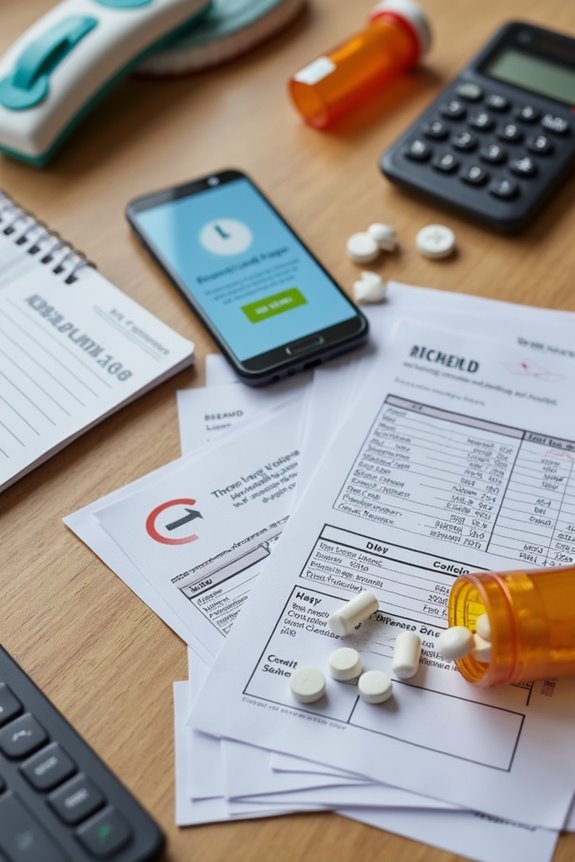To find low-cost pain management clinics, consider these options:
- Explore community health centers with sliding scale fees based on income.
- Seek Federally Qualified Health Centers (FQHCs) offering extensive services.
- Investigate nonprofit organizations that provide affordable treatments.
- Use telemedicine services for remote consultations at lower costs.
Verify clinic quality through accreditation and provider credentials. Address transportation barriers by looking into non-emergency transport services. Additional strategies for managing costs can further enhance access to care.
Key Takeaways
- Search for community health centers and Federally Qualified Health Centers (FQHCs) that offer sliding scale fees based on income for pain management services.
- Explore nonprofit organizations that provide affordable pain treatments, particularly for specific groups like veterans or low-income individuals.
- Utilize telemedicine services for remote consultations, which can reduce travel costs and offer affordable care options through subscription models.
- Investigate local health fairs and workshops that may offer free screenings or low-cost pain management programs, such as exercise and coping strategies.
- Confirm clinic credentials and compliance with regulations to ensure quality care, prioritizing those accredited by recognized organizations like The Joint Commission.
Understanding the Need for Affordable Pain Management
Understanding the need for affordable pain management is critical, especially as the global demand for effective pain solutions continues to rise. The projected growth of the pain management drug market from USD 87.19 billion in 2025 to over USD 125 billion by 2034 underscores the urgency.
Key factors include:
- Patient Demographics: Increasing prevalence of chronic pain conditions affects diverse populations, many of whom lack adequate insurance or financial resources.
- Treatment Affordability: High costs of non-opioid treatments often limit access, with generic opioids costing as little as $0.50/day compared to newer options at approximately $31/day.
The rising healthcare costs and opioid-related risks further amplify the demand for cost-effective, safer alternatives, making accessibility a pressing concern across various patient demographics.
Types of Clinics Offering Low-Cost Pain Management

Accessing affordable pain management is a vital consideration for many individuals facing chronic pain conditions. Various types of clinics provide low-cost options:
- Hospital Clinics: Affiliated with medical centers, offering multidisciplinary care and sometimes sliding scale fees.
- Community Centers: Federally Qualified Health Centers (FQHCs) deliver holistic pain management, focusing on underserved populations.
- Nonprofit Organizations: Operate on donations, providing basic treatments and catering to specific groups, like veterans.
- Pain Networks: Chains offering standardized treatments with sliding scale payments based on income, often in multiple states.
- Telemedicine Services: Facilitate remote consultations, reducing travel costs and providing affordable care through subscription models.
These clinics represent varied avenues for accessing essential pain management services while addressing financial constraints.
Key Pain Management Techniques Available at Low Cost

When individuals seek low-cost pain management solutions, they often explore a variety of techniques that do not rely heavily on pharmaceuticals. Key options include:
- Neurostimulation techniques: Utilize electrical impulses to disrupt pain signals.
- Relaxation methods: Include deep breathing and guided imagery to reduce anxiety.
- Therapeutic massage: Eases muscle tension and improves circulation.
- Acupuncture benefits: Stimulates specific points to activate natural analgesics.
- Yoga practice: Combines stretching and mindfulness to alleviate chronic pain.
- Mindfulness meditation: Enhances awareness, diminishing pain’s emotional impact.
- Heat therapy: Applies warm compresses for inflammation relief.
- Cold therapy: Uses ice packs to soothe pain.
These methods offer cost-effective alternatives while minimizing reliance on pharmaceuticals, making them accessible for many individuals.
Economic Factors to Consider When Choosing a Clinic

Economic factors play an essential role in determining the affordability and accessibility of pain management clinics. Key considerations include:
- Clinic Type: Costs vary considerably among private, public, and nonprofit clinics, with multidisciplinary clinics often charging higher fees.
- Location: Urban clinics typically incur higher operational costs due to real estate and salaries, while rural clinics may offer lower costs but fewer services.
- Insurance Coverage: Clinics that accept various insurance plans, including Medicaid and Medicare, provide more affordable options. Without insurance, direct payments can increase overall costs.
- Service Offerings: Clinics focusing on core treatments may limit advanced therapies to control expenses, while those with advanced capabilities may charge higher fees.
Understanding these economic disparities and clinic regulations is crucial for informed decision-making.
Accessibility Issues in Pain Management for Low-Income Individuals

Accessibility issues in pain management considerably affect low-income individuals, creating barriers that hinder effective treatment.
- Pain Medication Access: Over 80% of the global population lacks access to effective pain treatments, particularly in low- and middle-income countries (LMICs). Essential analgesics are largely unavailable, leading to untreated chronic pain.
- Chronic Pain Stigma: Sociocultural factors exacerbate these issues, as stigma surrounding pain and opioid use deters individuals from seeking necessary care.
- Healthcare Infrastructure: Training deficiencies among healthcare providers limit their ability to manage pain effectively, while inadequate integration of pain management services into primary healthcare exacerbates accessibility challenges.
- Economic Impact: Chronic pain prevalence in low-income populations contributes to mental health issues and decreased productivity, perpetuating cycles of poverty and health disparities.
Utilizing Community Resources to Find Clinics
Utilizing community resources to locate low-cost pain management clinics is essential for individuals facing financial constraints. Community outreach programs often connect patients with local health clinics that provide sliding scale fees.
Key resources include:
- Federally Qualified Health Centers (FQHCs) that offer integrated care and pain management.
- Nonprofit clinics providing complementary therapies, such as acupuncture and physical therapy, often at low or no cost.
- Multi-disciplinary teams within clinics that combine various specialties to address thorough pain management.
- Online directories and hotlines maintained by advocacy groups assist in guiding available services.
Resource sharing among community organizations enhances access, ensuring that patients receive the necessary support to manage their pain effectively.
Verifying the Quality of Low-Cost Pain Management Clinics
How can individuals guarantee they are selecting a quality low-cost pain management clinic?
Credential Verification
- Verify the credentials of providers through official registries. Look for board certifications from recognized bodies, such as the American Board of Pain Medicine.
- Confirm that all staff maintain current licensure and meet continuing medical education requirements.
Clinic Accreditation
- Ascertain the clinic complies with state and federal regulations. Accreditation from organizations like The Joint Commission signals adherence to high standards.
- Investigate the clinic’s accreditation level, ranging from Bronze to Gold, which reflects the quality of care provided.
Safety Measures
– Review the clinic’s documentation practices for opioid stewardship and harm reduction strategies, indicating a commitment to patient safety and responsible care.
The Role of Telehealth in Affordable Pain Management
Telehealth has emerged as a transformative approach in the domain of affordable pain management, allowing for innovative care delivery models.
- Hybrid Care Models: Telehealth integrates digital monitoring and virtual consultations with traditional visits, enhancing treatment flexibility.
- Access Improvement: Virtual consultations reduce geographic barriers, increasing access for patients in underserved areas.
- Timely Adjustments: Telehealth facilitates real-time modifications to care plans based on patient-reported outcomes.
- Group Dynamics: Telehealth group visits foster patient engagement and support, offering scalable and cost-effective solutions.
The telehealth benefits include improved treatment effectiveness, reduced travel costs, and increased patient continuity of care. Ongoing development focuses on harmonizing telehealth protocols with in-person care to guarantee quality and consistency.
Strategies for Effective Pain Management on a Budget
Effective pain management on a budget requires careful consideration of various strategies that maximize resources while minimizing costs.
Utilizing Community Resources****
- Seek community health centers offering sliding scale fees based on income.
- Investigate Federally Qualified Health Centers (FQHCs) for extensive pain management services.
- Participate in low-cost workshops from local nonprofits focusing on exercise and coping strategies.
Leveraging Nonpharmacologic Therapies****
- Engage in group aerobic exercises, which can effectively replace individual therapy for low back pain.
- Explore low-cost programs like yoga or tai chi that promote pain reduction.
Technology and Support
- Utilize pain management apps to track symptoms and connect with support networks.
- Foster community support to enhance motivation and access to shared resources.
Overcoming Transportation Barriers to Access Care
Transportation barriers greatly hinder access to healthcare for many individuals, particularly among vulnerable populations. Approximately 3.6 million Americans forgo medical care annually due to issues such as lack of vehicle access and long travel distances.
Key factors include:
- Absence of personal vehicles: Limits mobility and access to clinics.
- Public transit deficiencies: Inadequate routes and unreliable schedules exacerbate access issues.
- High transportation costs: Financial burdens make travel prohibitive for low-income households.
To overcome these barriers, communities can implement:
- Transportation options: Non-emergency medical transport services can assist patients.
- Mobility solutions: Expanding public transit routes to healthcare facilities can greatly reduce travel challenges, thereby improving overall health access.
Frequently Asked Questions
What Should I Expect During My First Visit to a Low-Cost Clinic?
During the initial assessment, patients can expect a thorough review of their pain history and physical evaluation. Treatment options will be discussed, focusing on personalized plans that consider both medical needs and financial circumstances.
Can I Bring a Family Member or Friend to My Appointment?
Research indicates that 70% of patients benefit from appointment support through companionship. Visitor policies typically permit family or friends, fostering emotional reassurance and enhancing communication, while respecting patient privacy during sensitive discussions and examinations in clinical settings.
Are There Age Restrictions for Patients Seeking Pain Management Services?
Age eligibility for pain management services often varies, with pediatric services typically starting around age 12. Specialized clinics address youth needs, ensuring a supportive environment for treatment while adhering to clinical guidelines and safety considerations.
How Do Low-Cost Clinics Handle Medication Prescriptions and Refills?
How do low-cost clinics guarantee responsible medication management? Their medication policies emphasize safety, with strict refill procedures, limiting dosages and encouraging collaboration between patients and providers to foster a supportive environment for effective pain management.
Is Transportation Assistance Available Through Low-Cost Pain Management Clinics?
Transportation assistance is frequently available through low-cost pain management clinics, offering various transportation options. Clinic partnerships enhance accessibility, ensuring patients can attend appointments consistently, fostering a sense of community and support among those seeking care.





